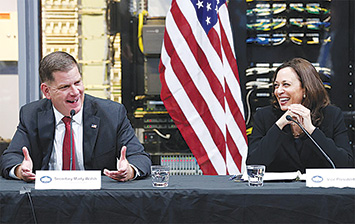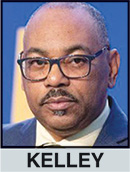Executive action will make it easier for federal workers to join a union
By TIM ROWDEN
Managing Editor

Washington – The White House announced two executive actions aimed at getting more of the 2.1 million employees of the federal government into a union.
Currently, most federal workers are eligible to join one, but only about 20 percent of the workforce has actually gone through the process to become union members.
The actions, announced by Vice President Kamala Harris and Labor Secretary Marty Walsh, will do two things:
• For new hires, the government will be required to educate applicants about unions during the hiring and onboarding process. Unions will also be given a chance to participate in new employee training sessions.
• For current employees, employers will need to communicate more clearly throughout the year about their collective bargaining rights and how to contact their unions.
TASK FORCE TO PROMOTE UNIONS
These recommendations stem from Harris and Walsh meeting with union leaders as part of the White House Labor Task Force, established by President Biden to make recommendations on steps the White House could take to promote union membership. Harris is the task force chair and Walsh is the vice chair of the group.
 “The Biden White House has made promoting unions a policy of the office,” Brian Young, of UCOMM Blog wrote. “Over the last 50 years, union membership has decreased significantly, and the White House has said that the drop has cost workers $200 billion a year in unrealized wages and benefits. Biden has said that he will be the most pro-union President in history but has been stymied in getting legislation passed by the deadlock in Congress, so an executive action like this is a welcome move, especially after Trump signed so many executive orders to take away unions’ power.”
“The Biden White House has made promoting unions a policy of the office,” Brian Young, of UCOMM Blog wrote. “Over the last 50 years, union membership has decreased significantly, and the White House has said that the drop has cost workers $200 billion a year in unrealized wages and benefits. Biden has said that he will be the most pro-union President in history but has been stymied in getting legislation passed by the deadlock in Congress, so an executive action like this is a welcome move, especially after Trump signed so many executive orders to take away unions’ power.”
The move was praised by federal unions who hope the executive actions will encourage federal workers, especially those who are not informed of the union in their workplace, to sign up.
 “For too long, there has been a concerted effort by corporations and wealthy individuals to prevent working people from organizing and bargaining collectively to better their working conditions and standard of living,” said American Federation of Government Employees (AFGE) President Everett Kelley. “Indeed, in the past decades, we saw this fight play out inside our own federal government – with an attempt to undermine employees’ independent unions and corrupt the apolitical civil service.
“For too long, there has been a concerted effort by corporations and wealthy individuals to prevent working people from organizing and bargaining collectively to better their working conditions and standard of living,” said American Federation of Government Employees (AFGE) President Everett Kelley. “Indeed, in the past decades, we saw this fight play out inside our own federal government – with an attempt to undermine employees’ independent unions and corrupt the apolitical civil service.
“As workers across the country find their voices, exercise their power, and win transformational victories in a historic month of Labor activism, we applaud the steps that the Biden administration is taking today to roll back attacks on Labor unions, help federal employees understand their union rights, and support them in exercising those rights,” Kelley said.
“AFGE thanks Vice President Kamala Harris, Secretary of Labor Marty Walsh, and others on the Task Force on Worker Organizing and Empowerment for their excellent work on these issues and their unwavering support of American workers.”
STARK CONTRAST TO TRUMP ADMINISTRATION
“Elections have consequences,” said Matt Biggs, president of the International Federation of Professional and Technical Engineers (IFPTE).
 “Today’s announcement by Vice President Kamala Harris and U.S. Secretary of Labor Marty Walsh on boosting union representation in the federal sector is a positive consequence that stands in stark contrast to the policies of the previous administration.”
“Today’s announcement by Vice President Kamala Harris and U.S. Secretary of Labor Marty Walsh on boosting union representation in the federal sector is a positive consequence that stands in stark contrast to the policies of the previous administration.”
IFTPE represents 90,000 highly skilled workers in the public and private sector, including tens of thousands of skilled professionals who work in a wide range of occupations including immigration judges, at the Department of Justice, engineers and technical workers at the Department of Defense, administrative law judges who hear cases at the Social Security Administration, and rocket scientists and technicians at NASA.
The Trump administration tried to strip union rights from IFPTE members who were serving as federal immigration judges in an attempt to silence them, Biggs said.
“In the Trump years, IFPTE members, civilian employees of the U.S. Department of Defense, and other areas of the federal government saw their ability to offer suggestions to improve their agencies curtailed because Labor/management committees were shut down,” he said.
Last year, in the darkest days of the pandemic with near-record unemployment confronting the country, the federally owned and operated Tennessee Valley Authority tried to lay off hundreds of IT professionals and outsource their jobs to tech firms overseas.
“Only because those federal workers were represented by our union were they able to launch a successful campaign to keep the work in the United States and prevent the spread of sensitive information about the electric grid and nuclear facilities,” he said.
UNIQUE CHALLENGES FOR FEDERAL WORKERS
Federal workers share the same challenges that employees of large private sector employers face, but they also have their own special workplace issues, Biggs said. For example, IFPTE members at NASA and other agencies were deemed “non-essential,” went without paychecks and were locked out of their offices during the last government shutdown.
“IFPTE applauds the Biden administration for continuing to understand that a healthy and prosperous middle class is directly linked to increased union density,” Biggs said. “Today’s announcement is good news for both federal Labor and management.”
With approval of Labor unions is at a 65-year high according to the latest Gallup poll, Biggs said, “Having a more unionized workplace should help the federal government recruit and retain skilled labor, operate more efficiently, and boost morale for federal workers.”



I have been a Union member for 67 years. I have witnessed good and less
than that in examples from the people working in large project’s for large Employers and those on small jobs working for small Employers. Whether or not which condition the people are in. The strength of the Union depends on each individual’s performance and adherence to his/her knowledge of the binding contract between the Employers and the Union as well as their knowledge of the rules of the
Organization (Union) they belong to.
When both sides of the problem on a project are adhered to in an effort for a resolution the result most usually is
resolved.
resolution